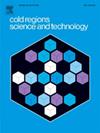冻土力学特性的试验研究进展
IF 3.8
2区 工程技术
Q1 ENGINEERING, CIVIL
引用次数: 0
摘要
冻土由于冰和未冻水的共存而表现出独特的力学行为,这使得实验研究对寒冷地区的工程应用至关重要。本文综述了在静态和动态载荷下对冻土的实验室研究,包括单轴和三轴压缩、蠕变、直接剪切和冻融循环试验。对应力-应变特性、破坏机制以及温度和时间的影响等方面的主要研究成果进行了综合。综述了计算机断层扫描(CT)、扫描电镜(SEM)、核磁共振(NMR)和汞侵入孔隙度测定(MIP)等微观结构分析技术的进展,以阐明冻土内部结构的演变。虽然取得了重大进展,但需要进一步努力更好地复制复杂的环境和负载条件,并充分了解多种影响因素之间的相互作用。未来的研究应侧重于开发新的实验技术,建立标准化的测试方案,建立全面的数据库,以提高数据的可及性和推进冻土研究。这一综述为冻土力学提供了重要的见解,并支持本构模型和数值模拟的验证,为寒冷地区的基础设施设计和建设提供了帮助。本文章由计算机程序翻译,如有差异,请以英文原文为准。
State of the art of mechanical behaviors of frozen soils through experimental investigation
Frozen soils exhibit unique mechanical behavior due to the coexistence of ice and unfrozen water, making experimental studies essential for engineering applications in cold regions. This review comprehensively examines laboratory investigations on frozen soils under static and dynamic loadings, including uniaxial and triaxial compression, creep, direct shear, and freeze-thaw (F-T) cycle tests. Key findings on stress-strain characteristics, failure mechanisms, and the effects of temperature and time are synthesized. Advancements in microstructural analysis techniques, such as computed tomography (CT), scanning electron microscopy (SEM), nuclear magnetic resonance (NMR), and mercury intrusion porosimetry (MIP), are also summarized to elucidate the internal structural evolution of frozen soils. While significant progress has been made, further efforts are needed to better replicate complex environmental and loading conditions and to fully understand the interactions between multiple influencing factors. Future research should focus on developing novel experimental techniques, establishing standardized testing protocols, and creating a comprehensive database to enhance data accessibility and advance frozen soil research. This review provides critical insights into frozen soil mechanics and supports validating constitutive models and numerical simulations, aiding infrastructure design and construction in cold regions.
求助全文
通过发布文献求助,成功后即可免费获取论文全文。
去求助
来源期刊

Cold Regions Science and Technology
工程技术-地球科学综合
CiteScore
7.40
自引率
12.20%
发文量
209
审稿时长
4.9 months
期刊介绍:
Cold Regions Science and Technology is an international journal dealing with the science and technical problems of cold environments in both the polar regions and more temperate locations. It includes fundamental aspects of cryospheric sciences which have applications for cold regions problems as well as engineering topics which relate to the cryosphere.
Emphasis is given to applied science with broad coverage of the physical and mechanical aspects of ice (including glaciers and sea ice), snow and snow avalanches, ice-water systems, ice-bonded soils and permafrost.
Relevant aspects of Earth science, materials science, offshore and river ice engineering are also of primary interest. These include icing of ships and structures as well as trafficability in cold environments. Technological advances for cold regions in research, development, and engineering practice are relevant to the journal. Theoretical papers must include a detailed discussion of the potential application of the theory to address cold regions problems. The journal serves a wide range of specialists, providing a medium for interdisciplinary communication and a convenient source of reference.
 求助内容:
求助内容: 应助结果提醒方式:
应助结果提醒方式:


